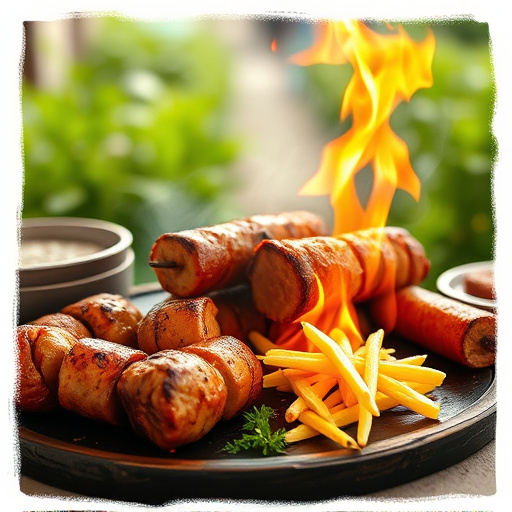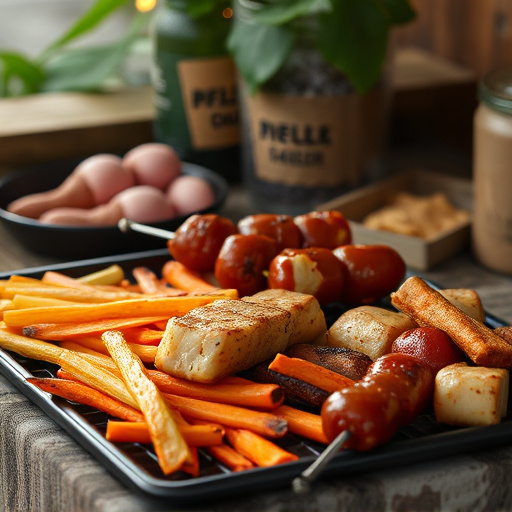Choose tender shoulder or butt cuts for shredded pork. Season with salt, pepper, paprika, garlic powder, and brown sugar. Slow cook 8-10 hours for collagen breakdown. Tear cooked pork with a fork to shred. Elevate flavor with BBQ sauces. Serve with buns, coleslaw, and sides like fries or beans.
“Unleash the ultimate comfort food with this guide to cooking the perfect pulled pork BBQ. Discover the secrets to tender, flavorful meat that melts in your mouth. From choosing the right cut of pork to mastering the art of seasoning and slow cooking, we’ll navigate you through every step. Learn techniques for pulling and shredding to perfection, and explore a variety of BBQ sauces to elevate your dish. Serve it up with our delicious suggestions and impress your taste buds with this classic pulled pork BBQ recipe.”
- Choose Your Cut of Pork for Tender Pulled Pork
- Seasoning: The Key to Flavorful Pulled Pork
- Slow Cooking 101: How Long to Cook Pulled Pork
- Pulling and Shredding: Techniques for Perfect Texture
- BBQ Sauces: Adding Kick to Your Pulled Pork
- Serving Suggestions for Delicious Pulled Pork BBQ
Choose Your Cut of Pork for Tender Pulled Pork

When it comes to achieving tender, succulent pulled pork in your overnight cook, selecting the right cut is key. Opt for a shoulder or butt cut, as these contain more connective tissue and fat, which break down slowly during the long, low-and-slow cooking process, resulting in incredibly flavorful, shreddable meat. These cuts are also often more affordable than others, making them a great choice for budget-friendly pulled pork bbq recipes.
Look for a boneless packer cut from the shoulder or a brisket flat from the butt. These cuts have distinct marbling and fat distribution that will enhance the overall taste and moisture of your pulled pork. Remember, the slower the cooking time, the more important it is to choose a cut with enough fat to keep the meat tender and juicy throughout the overnight cook.
Seasoning: The Key to Flavorful Pulled Pork

Seasoning is the cornerstone of any exceptional pulled pork BBQ recipe. The right blend of spices can transform simple pork into a mouthwatering delicacy. Start with a base of salt and pepper for a solid flavor foundation. Then, add smoky notes with paprika and a touch of cayenne pepper for heat—adjust to your preferred level of spice. Garlic and onion powders enhance the savory profile, while a sprinkle of brown sugar balances the flavors by adding a hint of sweetness.
Don’t be afraid to get creative with herbs like dried thyme or rosemary, which can add complexity. The magic happens when these seasonings are rubbed into the pork before slow-cooking it overnight. This process infuses every fiber of the meat, ensuring each bite is an explosion of flavor.
Slow Cooking 101: How Long to Cook Pulled Pork

Slow cooking is an art, and mastering it ensures mouthwatering pulled pork every time. When preparing a classic pulled pork BBQ recipe, the key lies in patience. Generally, it takes around 8 to 10 hours on low heat for the meat to achieve that tender, shreddable texture beloved in BBQ. This long, slow cooking process allows the collagen in the pork to break down, transforming it into gelatin and making it incredibly juicy and flavorful.
The ideal outcome is a pull-apart meat that glistens with its own juices, a true testament to the power of slow cooking. It’s essential to remember that every cooker is unique, so staying within this 8–10-hour range while adjusting according to your specific model ensures consistent, delicious results for your pulled pork BBQ recipe.
Pulling and Shredding: Techniques for Perfect Texture

When preparing pulled pork BBQ, the technique used for pulling and shredding the meat is crucial in achieving that perfect, tender texture. Start by cooking your pork slowly overnight, ensuring it becomes incredibly tender. Once cooked, let it rest before beginning the pulling process. Use a fork to gently tear apart the meat, aiming for uniform shreds. This method ensures each bite has the ideal balance of flavor and tenderness.
For optimal results, avoid using knives or cutting the meat too finely. The goal is to maintain a certain amount of structure while still creating shredded pieces. This technique not only preserves the meat’s natural juices but also results in a delightful, mouthwatering pulled pork BBQ experience.
BBQ Sauces: Adding Kick to Your Pulled Pork

BBQ sauces are an essential component in elevating your pulled pork dish, adding a kick and depth of flavor that sets it apart. When crafting your perfect pulled pork BBQ recipe, don’t underestimate the power of a well-chosen sauce. There’s a vast array of options to suit different palates: from sweet and tangy tomatobase sauces to smoky, spicy, or even honey-mustard varieties.
Each style offers a unique twist on the classic pulled pork dish, allowing you to experiment and find your favorite. Incorporating a BBQ sauce not only enhances the taste but also helps tenderize the meat during the slow cooking process. So, whether you’re a fan of a classic, all-American flavor profile or prefer something more adventurous, adding a BBQ sauce is a game-changer for any pulled pork lover.
Serving Suggestions for Delicious Pulled Pork BBQ

Once your slow cooker has done its magic and the meat is tender, it’s time to unleash your creativity with some mouthwatering serving suggestions for this delicious pulled pork BBQ. A classic choice is to serve it on a toasted bun with coleslaw, adding a tangy crunch that complements the rich, smoky flavor of the pork. You can also go the extra mile by adding barbecue sauce – either store-bought or homemade – for an authentic, lip-smacking experience.
For a more substantial meal, pair your pulled pork with traditional BBQ sides like crispy fries, baked beans, or a refreshing salad. Don’t forget about textures; incorporate elements like crispy onion rings or a sprinkle of crumbled cheese to take your pulled pork BBQ to the next level. These combinations will not only satisfy your taste buds but also create a well-rounded and satisfying meal for any occasion.
